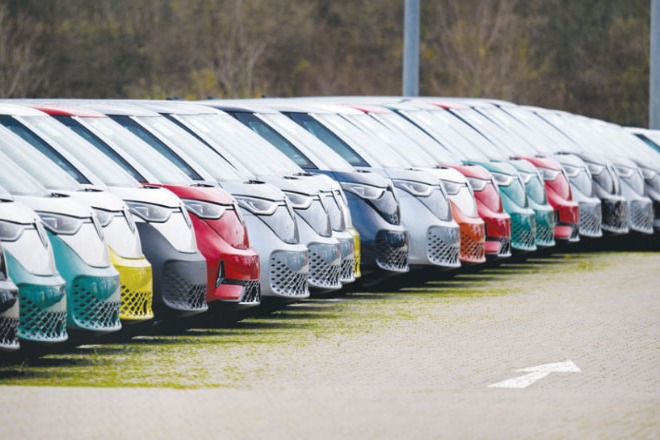Challenging yet attainable net-zero path


Editor's Note: To make the global fight against climate change a success, China has vowed to realize carbon neutrality before 2060 and worked out a blueprint to achieve low-carbon development. How can China turn that vision into reality? Five experts share their views on the issue with China Daily.
China has pledged to peak its carbon emissions before 2030 and achieve carbon neutrality before 2060, which is extremely challenging, given the country's energy-intensive growth model and coal-dominated energy mix and the short window to achieve those goals.
We (at Standard Chartered) expect China's gross emissions to peak at 10.8-11.6 gigatonnes, around 2030, assuming growth averages 5.5-6 percent a year during the 14th Five-Year Plan (2021-25) period, about 5 percent during the 15th Five-Year Plan (2026-30) and about 4 percent during 16th Five-Year Plan (2031-35), enabling the country to increase per capita GDP to the level of a "mid-tier developed country" by 2035.
Decarbonization will require a major transformation of China's economy, marked by a growing share of services, low-carbon and high-tech manufacturing in GDP, and a shift to renewable energy.
We believe China will strive to realize peak emissions at a relatively contained emissions level and ahead of 2030. But to do so, it will need to strictly stop approving of all new unabated (without carbon capture and storage) coal power plants and increase energy efficiency, while also developing emission reduction technology in the next decade.
On reaching peak emissions, China will need to speed up decarbonization by achieving carbon neutrality in selected fields by 2050. It will also need to move steadily away from energy-intensive industries and increasingly toward modern services and low-carbon and high-tech manufacturing, and transform the power sector by phasing out unabated coal power generation, and shifting to wind, solar, nuclear and hydro power.
To achieve overall net zero before 2060, in addition to increasing forest coverage, China will also need to increase its carbon capture and storage capacity to help absorb emissions from hard-to-abate sectors such as industrial processing and transportation.
China's path to carbon neutrality will likely entail structural changes across the economy, with a substantial impact on several industries, particularly on sectors such as electricity and heating, manufacturing, construction and transport, which together accounted for about 90 percent of the total emissions in 2018.
Coal-fired power plants have long been a dominant source of China's carbon emissions. So governance in the power sector needs to focus on low-carbon structural adjustments and power efficiency improvements, and we expect the government to gradually phase out coal-fired power plants and increase the competitiveness of wind and solar power.
By industry, iron and steel, chemicals, cement and building materials are key sources of carbon emissions. Phasing out unabated coal use in these sectors would require a combination of strategies, including device upgrading, electrification and low-carbon fuel switching (for example, to zero-carbon hydrogen or modern biomass). We expect the government to strengthen mandatory energy efficiency targets for industries to encourage low-carbon manufacturing.
We also expect it to launch comprehensive reforms, promoting a switch to low-carbon growth models for businesses, supporting an increased share of domestic consumption in GDP, and expanding the service sector.
As for the energy mix, the government aims to increase the share of non-fossil fuels in primary energy consumption to about 25 percent by 2030 from 15.3 percent in 2019. And to achieve carbon neutrality before 2060, China has to reduce the share of fossil fuel consumption to about 15 percent.
The government can use green hydrogen and biofuels in applications that are not amenable to electrification, such as long-distance surface transport, air transport, chemicals and high temperature heating. China already has research programs and pilot projects in these fields, so it only needs to make these options commercially competitive by incentivizing their use and achieving economies of scale.
Its strong manufacturing capability and large economies of scale put China in a good position to bridge the "valley of death" between R&D and mass application of research results in a financially viable manner. Mass production in China helped turn solar panels from a high-cost source of energy to the cheapest source of clean energy; it could achieve similar results for a broader range of renewable energy and industrial processes.
Under the Paris Agreement, the world's major economies are committed to implementing climate change mitigation policies that will raise carbon prices and reallocate resources to low-carbon industries. China could benefit from this, by investing substantially in clean energy, and once it starts "manufacturing" the bulk of its energy instead of extracting it from the ground, it could become a net supplier of clean energy and related manufacturing equipment.
While Chinese companies, in general, should more strictly monitor their products' carbon footprints in the supply chains and reduce carbon emissions in production as soon as possible to mitigate the impacts of climate change, those operating overseas should work with local partners to invest in green infrastructure, green manufacturing and technology, supported by green financing, to better align with the green commitment of the Belt and Road Initiative.
We estimate that to achieve carbon neutrality, China needs to invest 127-192 trillion yuan ($19.87-30.04 trillion) by 2060, equivalent to 3.2-4.8 trillion yuan of related investment per year. And the financial sector has a key role to play in funding green investment, managing climate change and industry transformation risks, as well as facilitating carbon pricing. Green finance sources, including green loans, bonds and equity financing, have immense potential to fund clean energy investment. So China should substantially increase the issuance of green bonds with longer tenors and green loans covering a wider range of green infrastructure, manufacturing upgrading and new technological development.
The current carbon price does not have a market price discovery function, as the market lacks liquidity, institutional investors and auction allowances. Cross-regional transactions are scarce, transactions are concentrated in certain periods each year, and market participants are enterprises with varying costs of emission reduction, while institutional investors still face barriers to market entry.
As a result, the carbon price in China's emissions trading market is volatile and very low; at 20-40 yuan a ton it is a fraction of the actual price. That's why the International Monetary Fund has said China will need to take additional measures to raise the carbon price to the global average of $75 a ton, in order to reduce emissions to a level consistent with keeping the global temperature rise to below 2 C by the end of this century.
As of 2019, carbon taxes had been implemented or were scheduled to be implemented in 25 countries. This could be an option for China as well given that carbon tax can set carbon prices directly, and carbon tax revenues can be used to finance investment in clean energy and related infrastructure, green technology and innovation, or to transfer to low-income groups that would be disproportionately affected by the transition to a low-carbon economy.
The views don't necessarily represent those of China Daily.
Shen Lan (left) and Ding Shuang are economists with Standard Chartered Bank.
































